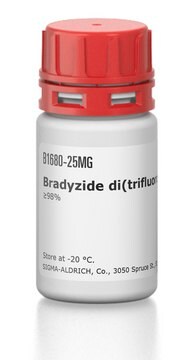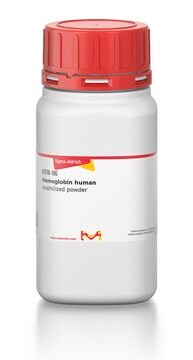C222
Cathine hydrochloride
≥97.5% (HPLC), powder, anorexic
Synonim(y):
threo-2-Amino-1-hydroxy-1-phenyl propane hydrochloride, Pseudonorephedrine hydrochloride, S,S-Norpseudoephedrine hydrochloride
About This Item
Polecane produkty
product name
Cathine hydrochloride,
Postać
powder
Poziom jakości
kontrola substancji
USDEA Schedule IV; Home Office Schedule 3; psychotrope (France); kontrollierte Droge in Deutschland; regulated under CDSA - not available from Sigma-Aldrich Canada; psicótropo (Spain); Decreto Lei 15/93: Tabela IIB (Portugal)
warunki przechowywania
desiccated
kolor
white to off-white
mp
172-175 °C
rozpuszczalność
H2O: 15 mg/mL, clear
0.1 M HCl: soluble
ethanol: soluble
Zastosowanie
forensics and toxicology
ciąg SMILES
Cl[H].C[C@H](N)[C@@H](O)c1ccccc1
InChI
1S/C9H13NO.ClH/c1-7(10)9(11)8-5-3-2-4-6-8;/h2-7,9,11H,10H2,1H3;1H/t7-,9+;/m0./s1
Klucz InChI
DYWNLSQWJMTVGJ-DKXTVVGFSA-N
Szukasz podobnych produktów? Odwiedź Przewodnik dotyczący porównywania produktów
Działania biochem./fizjol.
Przestroga
Hasło ostrzegawcze
Warning
Zwroty wskazujące rodzaj zagrożenia
Zwroty wskazujące środki ostrożności
Klasyfikacja zagrożeń
Acute Tox. 4 Oral - STOT SE 3
Organy docelowe
Central nervous system
Kod klasy składowania
11 - Combustible Solids
Klasa zagrożenia wodnego (WGK)
WGK 3
Temperatura zapłonu (°F)
Not applicable
Temperatura zapłonu (°C)
Not applicable
Środki ochrony indywidualnej
dust mask type N95 (US), Eyeshields, Gloves
Certyfikaty analizy (CoA)
Poszukaj Certyfikaty analizy (CoA), wpisując numer partii/serii produktów. Numery serii i partii można znaleźć na etykiecie produktu po słowach „seria” lub „partia”.
Masz już ten produkt?
Dokumenty związane z niedawno zakupionymi produktami zostały zamieszczone w Bibliotece dokumentów.
Nasz zespół naukowców ma doświadczenie we wszystkich obszarach badań, w tym w naukach przyrodniczych, materiałoznawstwie, syntezie chemicznej, chromatografii, analityce i wielu innych dziedzinach.
Skontaktuj się z zespołem ds. pomocy technicznej







